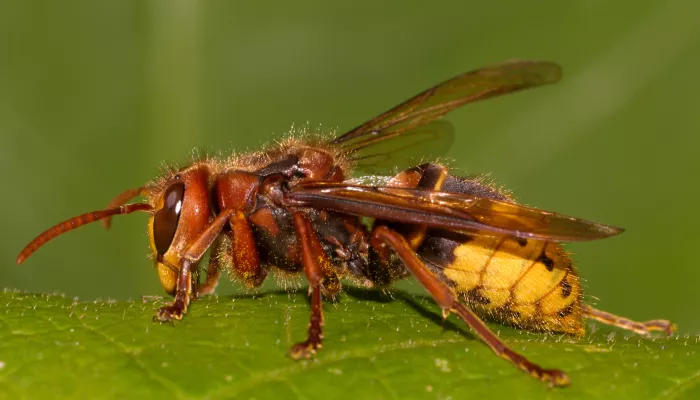Ruby-tailed wasp
If seen up close, the glittering Ruby-tailed wasp is, perhaps, one of the UK's most beautiful insects. A solitary wasp, it can be found in sandy and rocky habitats like quarries, outcrops and walls.

Some of our most important pollinators! Learn about the many species of bees and wasps we have in Kent and how to identify them.
If seen up close, the glittering Ruby-tailed wasp is, perhaps, one of the UK's most beautiful insects. A solitary wasp, it can be found in sandy and rocky habitats like quarries, outcrops and walls.
The common carder bee is a fluffy, gingery bumble bee that can often be found in gardens and woods, and on farmland and heaths. It is a social bee, nesting in cavities, old birds' nests and mossy lawns.
Living up to its name, the red-tailed bumblebee is black with a big, red 'tail'.
Living up to its name, the white-tailed bumblebee is black-and-yellow bee with a bright white 'tail'. A social bumble bee, it can be found nesting in gardens and woods, and on farmland and heaths.
Unsurprisingly, the garden bumblebee can be found in the garden, buzzing around flowers like foxgloves, cowslips and red clover. It is quite a large, scruffy-looking bee, with a white tail. It nests in colonies.
One of our prettiest and smallest bumble bees, the early bumblebee has a bright orange tail and lemon-yellow bands on its body. It is very common and can be found in all kinds of habitats in early spring.
The Tree bumblebee is a new arrival to the UK. First recorded here in 2001, it is slowly spreading north. It prefers open woodland and garden habitats and can be found nesting in bird boxes and roof spaces.
The Heath bumblebee is not only found on heathland, but also in gardens and parks. It nests in small colonies of less than 100 workers in all kinds of spots, such as old birds' nests, mossy beds and even roofs!
Spot these giants of the bumblebee world during springtime. They can be seen buzzing from flower to flower getting their pollen fix.
Honeybees are famous for the honey they produce! These easily recognisable little bees are hard workers, living in large hives made of wax honeycombs.
The shrill carder bee can be spotted flying quickly around flowers in unimproved pastures. The queens produce a loud, high-pitched buzz, hence the name. It is declining rapidly and is restricted to just a few locations.
The hairy-footed flower bee can be seen in gardens and parks in spring and summer, visiting tubular flowers like red dead-nettle and comfrey. As its name suggests, it has long, orange hairs on its middle legs.
Wasps are well-known, and unfortunately not very well-loved! But give these black and yellow guys a chance, as they are important pollinators and pest controllers.
The fearsome-looking hornet may not be a well-loved insect, but it is actually much less aggressive than the common wasp. It is also an important pollinator and a predator of species that feed on plants and crops, so can be a gardener's friend.
The appearance of semi-circular holes in the leaves of your garden plants is a sure sign that the patchwork leaf-cutter bee has been at work. It is one of a number of leaf-cutter bee species present in the UK.
The Red Mason Bee is a common, gingery bee that can be spotted nesting in the crumbling mortar of old walls. Encourage bees to nest in your garden by putting out a tin can full of short, hollow canes.
Also known as the two-coloured mason bee, this beautiful bee is famous for nesting in old snail shells.
The Tawny mining bee is a furry, gingery bee that can often be seen in parks and gardens during the springtime. Look for a volcano-like mound of earth in the lawn that marks the entrance to its burrow.
This black and grey solitary bee takes to the wing in spring, when it can be seen buzzing around burrows in open ground.
The Ivy Bee is a new arrival to the UK. First recorded here in 2001, it is slowly spreading north. It feeds exclusively on the nectar of Ivy flowers and can be seen in autumn when this plant is in bloom.
With yellow-and-black bands, the giant horntail looks like a large wasp, but is harmless to us. The female uses her long, stinger-like ovipositor to lay eggs in pine trees, where the larvae then develop.
One of our largest and most impressive solitary wasps, the bee wolf digs a nest in sandy spots and hunts honey bees.